中国国债市场发展历程 与经验介绍 A Brief Introduction to China
我国债券市场介绍
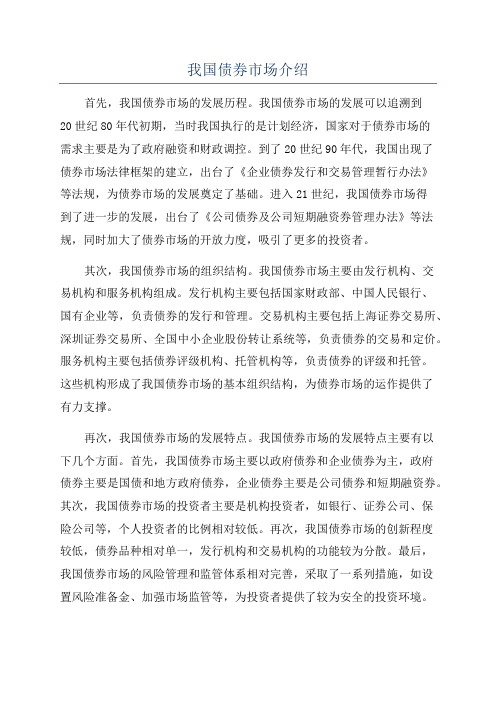
我国债券市场介绍首先,我国债券市场的发展历程。
我国债券市场的发展可以追溯到20世纪80年代初期,当时我国执行的是计划经济,国家对于债券市场的需求主要是为了政府融资和财政调控。
到了20世纪90年代,我国出现了债券市场法律框架的建立,出台了《企业债券发行和交易管理暂行办法》等法规,为债券市场的发展奠定了基础。
进入21世纪,我国债券市场得到了进一步的发展,出台了《公司债券及公司短期融资券管理办法》等法规,同时加大了债券市场的开放力度,吸引了更多的投资者。
其次,我国债券市场的组织结构。
我国债券市场主要由发行机构、交易机构和服务机构组成。
发行机构主要包括国家财政部、中国人民银行、国有企业等,负责债券的发行和管理。
交易机构主要包括上海证券交易所、深圳证券交易所、全国中小企业股份转让系统等,负责债券的交易和定价。
服务机构主要包括债券评级机构、托管机构等,负责债券的评级和托管。
这些机构形成了我国债券市场的基本组织结构,为债券市场的运作提供了有力支撑。
再次,我国债券市场的发展特点。
我国债券市场的发展特点主要有以下几个方面。
首先,我国债券市场主要以政府债券和企业债券为主,政府债券主要是国债和地方政府债券,企业债券主要是公司债券和短期融资券。
其次,我国债券市场的投资者主要是机构投资者,如银行、证券公司、保险公司等,个人投资者的比例相对较低。
再次,我国债券市场的创新程度较低,债券品种相对单一,发行机构和交易机构的功能较为分散。
最后,我国债券市场的风险管理和监管体系相对完善,采取了一系列措施,如设置风险准备金、加强市场监管等,为投资者提供了较为安全的投资环境。
最后,我国债券市场的发展前景。
我国债券市场的发展前景较为广阔。
首先,我国经济的快速发展和金融的不断深化,为债券市场的发展提供了良好的基础和条件。
其次,债券市场的开放程度逐渐加大,吸引了越来越多的国际投资者参与,进一步提高了债券市场的活跃度和流动性。
再次,债券市场创新的推进和债券品种的丰富化,将进一步满足不同投资者的需求,促进市场的健康发展。
中国债券市场 历史沿革

中国债券市场历史沿革中国债券市场历史沿革债券作为一种重要的借贷工具和融资方式,早在中国古代就已经有了,但现代化的中国债券市场则是在改革开放以后逐渐形成的。
下面对其历史沿革进行简要概述。
一、1980年代1980年代初期,中国尚未拥有完整的债券市场体系,只有国家发行的储蓄券和以工业企业为主体发行的企业债券。
直到1986年,国家在上海证券交易所试行国库券发行并上市,这标志着中国债券市场的起步。
二、1990年代1990年代初期,中国债券市场逐渐成形,除国债、地方政府债券和企业债券外,还引入境外机构投资者,发行了第一批境外机构投资者可投资人民币债券。
此外,还出现了基金公司和信托公司等专业化机构,提高了市场的专业化程度。
三、2000年代2000年代的中国债券市场进一步发展,政府积极推进国债市场化进程,各种债券品种逐渐推出。
2002年,国务院批准推进企业债券市场化试点,从此企业债券成为中国债券市场的重要组成部分。
近年来,央行推出的金融债券和债券回购等政策措施也在不断完善债券发行和交易机制。
四、2010年代到了2010年代,中国债券市场开始呈现崛起之势。
2010年至2015年期间,中国债券市场规模达到35.4万亿元,年均增长率为15.4%,远高于其他新兴市场。
此时,中国债券市场已经形成了国债、地方政府债券、企业债券、金融债券、短期融资券等多种债券品种,已经初具规模和完备性。
总的来说,中国债券市场的发展和壮大见证了中国资本市场的成长历程,也是国际资本市场对中国资产的认可。
未来,随着中国金融业的进一步开放和债券市场的持续改革创新,中国的债券市场必将呈现更加火爆和多元化的增长态势。
浅析我国债券市场发展现状及其趋势分析

浅析我国债券市场发展现状及其趋势分析中国的债券市场发展已有一段历史,并且是一个不断发展的市场。
随着国内经济的发展以及财政政策的逐步调整,债券作为一种融资工具得到了越来越广泛的应用。
本文将从我国债券市场的历史、现状以及未来趋势三个方面进行分析,希望能够为读者提供一些有价值的思考。
一、我国债券市场的历史我国债券市场的历史可以追溯到20世纪80年代,当时的债券市场还处于萌芽状态。
在1990年代初期,我国政府开始发行国债,并且开始了债券交易市场建设的工作。
1997年,我国首次发行了人民币债券,这被认为是我国债券市场发展的里程碑事件之一。
2000年,上海证券交易所成立,带动了债券市场的快速发展。
2005年,我国证券市场实行了“T+1”交易制度,这进一步促进了债券市场的发展。
2016年,债券通一号通道开通,有效整合了内地和香港债券市场,实现了两地债券市场互联互通。
在这些政策的推动下,我国债券市场得到了快速发展,相关数据也证明了此事实。
二、我国债券市场的现状当前我国债券市场规模已经达到了50万亿元,成为世界上最大的债券市场之一。
从市场参与者来看,我国债券市场主要由政府、银行和企业组成。
目前,中国债券市场的参与者结构呈现多元化特点,已经包括公募基金、券商、保险、财政、央行、企业等各类机构和个人投资者。
从市场类型来看,我国债券市场主要由国债、政策性银行债和公司债三类为主。
其中,国债作为最低风险资产,具有保值增值和风险分散等优势,备受投资者欢迎。
在债券市场的交易模式方面,目前我国债券市场主要分为场内和场外两种交易方式。
场内交易主要指交易所债券交易,场外交易主要指银行间市场债券交易。
场外交易是我国债券市场的主要交易方式,在债券市场的表现中,交易额和交易量均占据主导地位。
而场内交易的意义则在于,可以为投资者提供更为多样化的债券交易方式,增加了市场的竞争程度。
三、我国债券市场的趋势分析1. 完善法律法规在债券市场发展的过程中,完善相应的法律法规至关重要。
中国债券市场的发展与创新
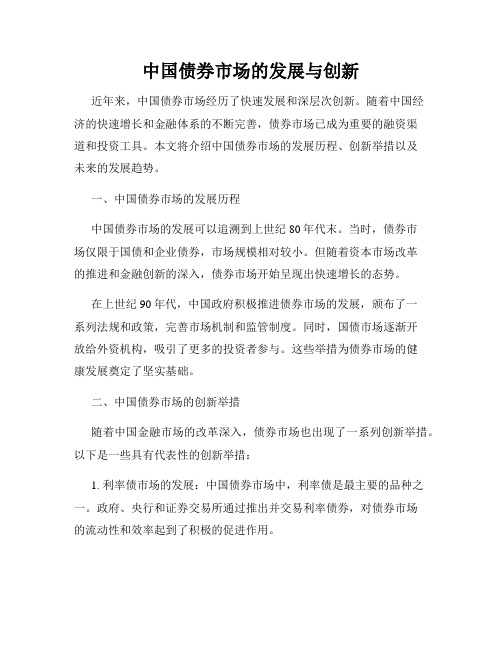
中国债券市场的发展与创新近年来,中国债券市场经历了快速发展和深层次创新。
随着中国经济的快速增长和金融体系的不断完善,债券市场已成为重要的融资渠道和投资工具。
本文将介绍中国债券市场的发展历程、创新举措以及未来的发展趋势。
一、中国债券市场的发展历程中国债券市场的发展可以追溯到上世纪80年代末。
当时,债券市场仅限于国债和企业债券,市场规模相对较小。
但随着资本市场改革的推进和金融创新的深入,债券市场开始呈现出快速增长的态势。
在上世纪90年代,中国政府积极推进债券市场的发展,颁布了一系列法规和政策,完善市场机制和监管制度。
同时,国债市场逐渐开放给外资机构,吸引了更多的投资者参与。
这些举措为债券市场的健康发展奠定了坚实基础。
二、中国债券市场的创新举措随着中国金融市场的改革深入,债券市场也出现了一系列创新举措。
以下是一些具有代表性的创新举措:1. 利率债市场的发展:中国债券市场中,利率债是最主要的品种之一。
政府、央行和证券交易所通过推出并交易利率债券,对债券市场的流动性和效率起到了积极的促进作用。
2. 企业债券市场的拓展:为了满足企业的融资需求,中国债券市场不断拓展企业债券品种。
包括普通企业债、中小企业私募债和短期融资券等,为企业提供了多样化的融资工具。
3. 绿色债券的发行:作为应对气候变化和环境保护的一种创新融资工具,绿色债券在中国债券市场逐渐兴起。
政府和金融机构推动了绿色债券的发行,加大对环保和可持续项目的资金支持。
4. 跨境债券市场的建设:为了提升中国债券市场的国际竞争力,中国政府正在积极建设跨境债券市场。
例如,“债券通”计划的推出,允许境外投资者直接投资内地债券市场,促进了市场的国际化发展。
三、中国债券市场的发展趋势展望未来,中国债券市场仍然具有良好的发展前景。
以下是一些预测和趋势:1. 市场规模持续扩大:随着国内资金供给的增加和投资者结构的不断优化,中国债券市场的规模将继续扩大。
同时,债券市场对外开放的步伐也将进一步加快。
国内债券市场详细介绍

萌芽阶段:1981年-1986年 1、中国债券市场以国债发行为主,发展较为缓慢。
2、这一阶段的企业集资行为既没有政府审批,也没有相应的法律法规规范。
到1986年底,约发行100亿元人民币企业债。
3、没有成型的债券交易机制或交易场所,债券不能进行转让和交易。
1981年,财政部正式发行国库券,我国债券市场由此产生。
1984年开始,少量企业因资金缺乏开始自发地开展向社会或企业内部集资等类似企业债券的融资活动。
1985年,为筹集国家基础建设资金,央行同意工行和农行发行金融债券。
起步阶段: 1987年-1997年 1、以国债为主体的债券二级市场开始形成,交易所市场处于主导地位。
2、由于出现了部分企业债券到期无法兑付的问题,同时为制止乱集资现象,企业债券经历了从人民银行到国家计委归口管理的转变。
1987年3月,《企业债券管理暂行条例》由国务院颁布实施。
1988年,国家分两批在61个城市进行国债流通转让试点,初步形成国债的场外交易市场。
1990年12月,上海与深圳两家证券交易所成立。
上交所成为我国主要的债券交易场所。
1993年,国务院颁布了《企业债券管理条例》,企业债券由国家计委归口管理。
1995年,国债在上交所招标发行试点成功。
为防止银行资金流入股市,1997年6月,商业银行退出交易所市场,同年全国银行间债券市场成立,由外汇交易中心系统作为前台报价系统,由中央国债登记结算公司作为后台托管结算系统。
规范整顿阶段: 1998年-2004年 1、该阶段的管理体制带有浓厚的计划经济色彩,债券审批程序长,企业债发行规模不大。
企业债券以大型央企和银行担保为信用基础,类似准政府债。
2、银行间债券市场框架基本形成。
2003年,央行票据的诞生标志着银行间债券市场的真正崛起。
1998年11月,人民银行颁布了《政策性银行金融债券市场发行管理暂行规定》。
1999年,证券公司和基金公司获准进入银行间市场。
2003年4月,中央银行票据正式成为央行公开市场操作的常规工具,银行间债券市场产生质的飞跃。
(完整版)概述我国国债发展史
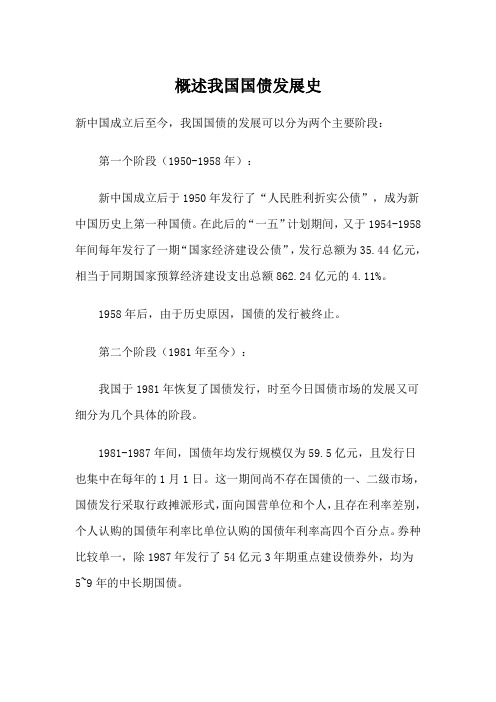
概述我国国债发展史新中国成立后至今,我国国债的发展可以分为两个主要阶段:第一个阶段(1950-1958年):新中国成立后于1950年发行了“人民胜利折实公债”,成为新中国历史上第一种国债。
在此后的“一五”计划期间,又于1954-1958年间每年发行了一期“国家经济建设公债”,发行总额为35.44亿元,相当于同期国家预算经济建设支出总额862.24亿元的4.11%。
1958年后,由于历史原因,国债的发行被终止。
第二个阶段(1981年至今):我国于1981年恢复了国债发行,时至今日国债市场的发展又可细分为几个具体的阶段。
1981-1987年间,国债年均发行规模仅为59.5亿元,且发行日也集中在每年的1月1日。
这一期间尚不存在国债的一、二级市场,国债发行采取行政摊派形式,面向国营单位和个人,且存在利率差别,个人认购的国债年利率比单位认购的国债年利率高四个百分点。
券种比较单一,除1987年发行了54亿元3年期重点建设债券外,均为5~9年的中长期国债。
1988-1993年间国债年发行规模扩大到284亿元,增设了国家建设债券、财政债券、特种国债、保值公债等新品种。
1988年国家分两批在61个城市进行国债流通转让试点,初步形成了国债的场外交易市场。
1990年后国债开始在交易所交易,形成国债的场内交易市场,当年国债交易额占证券交易总额120亿元的80%以上。
1991年我国开始试行国债发行的承购包销;1993年10月和12月上海证券交易所正式推出了国债期货和回购两个创新品种。
1994年财政部首次发行了半年和一年的短期国债;1995年国债二级市场交易活跃,特别是期货交易量屡创纪录,但包括“3.27”事件和回购债务链问题等违规事件频频出现,致使国债期货交易于5月被迫暂停。
1996年国债市场出现了一些新变化:首先是财政部改革以往国债集中发行为按月滚动发行,增加了国债发行的频度;其次是国债品种多样化,对短期国债首次实行了贴现发行,并新增了最短期限为3个月的国债,还首次发行了按年付息的十年期和七年期附息国债;第三是在承购包销的基础上,对可上市的8期国债采取了以价格(收益率)或划款期为标的的招标发行方式;第四是当年发行的国债以记帐式国库券为主,逐步使国债走向无纸化。
中国债券市场的发展过程是怎样的归纳
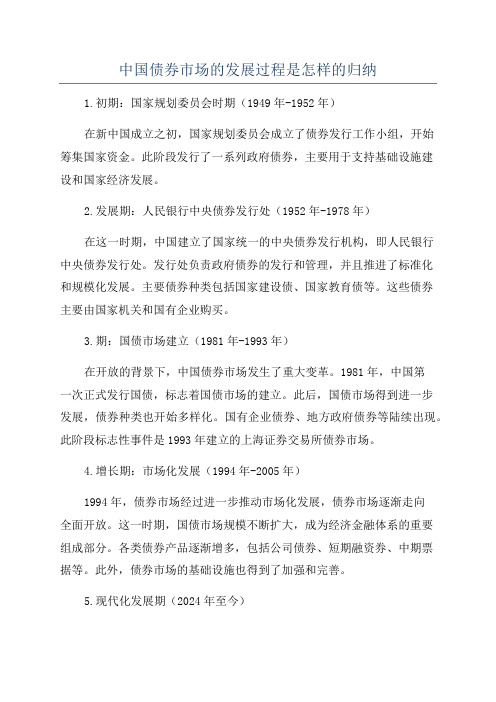
中国债券市场的发展过程是怎样的归纳1.初期:国家规划委员会时期(1949年-1952年)在新中国成立之初,国家规划委员会成立了债券发行工作小组,开始筹集国家资金。
此阶段发行了一系列政府债券,主要用于支持基础设施建设和国家经济发展。
2.发展期:人民银行中央债券发行处(1952年-1978年)在这一时期,中国建立了国家统一的中央债券发行机构,即人民银行中央债券发行处。
发行处负责政府债券的发行和管理,并且推进了标准化和规模化发展。
主要债券种类包括国家建设债、国家教育债等。
这些债券主要由国家机关和国有企业购买。
3.期:国债市场建立(1981年-1993年)在开放的背景下,中国债券市场发生了重大变革。
1981年,中国第一次正式发行国债,标志着国债市场的建立。
此后,国债市场得到进一步发展,债券种类也开始多样化。
国有企业债券、地方政府债券等陆续出现。
此阶段标志性事件是1993年建立的上海证券交易所债券市场。
4.增长期:市场化发展(1994年-2005年)1994年,债券市场经过进一步推动市场化发展,债券市场逐渐走向全面开放。
这一时期,国债市场规模不断扩大,成为经济金融体系的重要组成部分。
各类债券产品逐渐增多,包括公司债券、短期融资券、中期票据等。
此外,债券市场的基础设施也得到了加强和完善。
5.现代化发展期(2024年至今)在进入21世纪后,中国债券市场迎来了现代化的发展阶段。
债券市场规模不断扩大,与国际接轨的标准和机制得到了引入和创新。
此外,政府还推动了债券市场的多层次发展,例如设立了中小企业私募债券、地方政府债券等品种,以满足各类投资者的需求。
同时,债券市场监管和市场参与者的意识也得到了提高。
总结起来,中国债券市场的发展经历了从初期的政府债券发行,到发展期的中央债券发行处,再到期的国债市场建立,而后是增长期的市场化发展,最终进入现代化发展期。
随着经济和金融体系的不断发展,中国债券市场已经成为全球规模最大的债券市场之一,为资本市场的稳定和企业融资提供了重要的支持和发展空间。
论我国债券市场发展
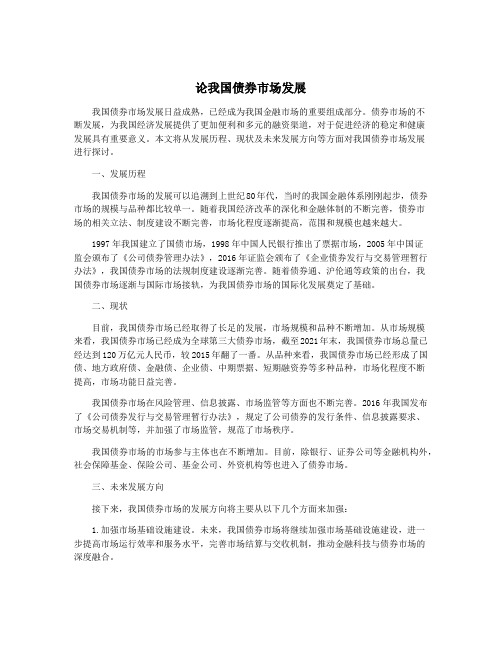
论我国债券市场发展我国债券市场发展日益成熟,已经成为我国金融市场的重要组成部分。
债券市场的不断发展,为我国经济发展提供了更加便利和多元的融资渠道,对于促进经济的稳定和健康发展具有重要意义。
本文将从发展历程、现状及未来发展方向等方面对我国债券市场发展进行探讨。
一、发展历程我国债券市场的发展可以追溯到上世纪80年代,当时的我国金融体系刚刚起步,债券市场的规模与品种都比较单一。
随着我国经济改革的深化和金融体制的不断完善,债券市场的相关立法、制度建设不断完善,市场化程度逐渐提高,范围和规模也越来越大。
1997年我国建立了国债市场,1998年中国人民银行推出了票据市场,2005年中国证监会颁布了《公司债券管理办法》,2016年证监会颁布了《企业债券发行与交易管理暂行办法》,我国债券市场的法规制度建设逐渐完善。
随着债券通、沪伦通等政策的出台,我国债券市场逐渐与国际市场接轨,为我国债券市场的国际化发展奠定了基础。
二、现状目前,我国债券市场已经取得了长足的发展,市场规模和品种不断增加。
从市场规模来看,我国债券市场已经成为全球第三大债券市场,截至2021年末,我国债券市场总量已经达到120万亿元人民币,较2015年翻了一番。
从品种来看,我国债券市场已经形成了国债、地方政府债、金融债、企业债、中期票据、短期融资券等多种品种,市场化程度不断提高,市场功能日益完善。
我国债券市场在风险管理、信息披露、市场监管等方面也不断完善。
2016年我国发布了《公司债券发行与交易管理暂行办法》,规定了公司债券的发行条件、信息披露要求、市场交易机制等,并加强了市场监管,规范了市场秩序。
我国债券市场的市场参与主体也在不断增加。
目前,除银行、证券公司等金融机构外,社会保障基金、保险公司、基金公司、外资机构等也进入了债券市场。
三、未来发展方向接下来,我国债券市场的发展方向将主要从以下几个方面来加强:1.加强市场基础设施建设。
未来,我国债券市场将继续加强市场基础设施建设,进一步提高市场运行效率和服务水平,完善市场结算与交收机制,推动金融科技与债券市场的深度融合。
我国债券市场开放历程、日韩开放经验及政策建议

我国债券市场开放历程、日韩开放经验及政策建议债券市场对外开放是指放宽或取消对市场参与者在债券市场对外活动中的限制。
本文重点回顾了我国境内债券市场对外开放的主要历程,对日本、韩国债券市场开放经验进行总结,并提出了相关政策建议。
一、我国债券市场对外开放主要历程(一)2005-2009年,债券市场尝试开放阶段。
《国际开发机构人民币债券发行管理暂行办法》(中国人民银行财政部国家发展和改革委员会中国证券监督管理委员会公告〔2005〕第5号公布)明确了境外主体在境内发债的资格条件、申请流程、信息披露标准、资金用途管理、外汇管理等事项。
2005年10月,世界银行集团下属国际金融公司、亚洲开发银行分别获准在境内债券市场上发行规模为11.3亿元和10亿元的人民币债券。
这一阶段的政策较严格,发行主体类型严格限制为国际开发机构,在外汇管理方面规定国际开发机构发行人民币债券所筹集的资金主要用于中国境内项目。
(二)2010-2015年,作为人民币国际化战略配套的规模化开放阶段。
主体方面,“规模化”引入境外投资者。
2010年8月,《中国人民银行关于境外人民币清算行等三类机构运用人民币投资银行间债券市场试点有关事宜的通知》(银发〔2010〕217号)明确允许境外中央银行或货币当局,香港、澳门地区人民币业务清算行,跨境贸易人民币结算境外参加银行投资境内银行间债券市场,并规定了相关境外投资者的准入管理、交易方式和托管结算方式。
2013年3月中国人民银行印发了《中国人民银行关于合格境外机构投资者投资银行间债券市场有关事项的通知》(银发〔2013〕69号),允许获得中国证监会核发合格投资者资格及国家外汇管理局核批投资额度的合格投资者进入银行间债券市场。
(三)2015年至今,配合SDR要求走向全面开放阶段。
2016年人民币正式纳入SDR篮子,对债券市场的开放提出了更高的要求,中国债券市场逐步走向“全面开放”阶段。
2016年3月,人民银行第3号公告,将符合条件的境外机构投资者范围拓宽至商业银行、保险公司、证券公司、基金管理公司及其他资产管理机构等各类金融机构,取消境外投资者的投资额度限制,进一步简化准入备案流程。
中国债券市场发展历程与行情分析(个人呕心沥血半个月总结出来的成果)

中国债券市场发展历程与行情分析中国国债市场发展历程一、传统体制下的国债市场(一)1950-1958年,发行“人民胜利折实公债”和“国家经济建设公债”1、针对国有企业和事业单位。
2、不流通。
3、完全政府行为。
(二)1959-1980年,“空白期”,无国债发行二、改革开放后的中国国债市场(一)1981-1987年,国债恢复发行和市场机制引入1、经济改革引发的国债发行(国有企业改革)。
2、没有一级市场和二级市场。
3、国债发行采取行政分配方式。
4、具有一定的市场化表现,适当提高国债利率并缩短国债期限。
5、开始面向个人发行国债。
(二)1988-1991年,实物券柜台市场主导时期——早期的场外市场1、1988年,尝试通过商业银行和邮政储蓄的柜台销售方式发行实物国债,开始出现了国债一级市场,同一年,国债二级市场(柜台交易市场)也初步形成。
2、1991年,以场外柜台交易市场为主、场内集中交易市场为辅的国债二级市场格局基本形成。
3、发行方式逐步由柜台销售、承购包销过渡到公开招标。
4、期限品种基本上以3年期和5年期为主。
(三)1991-1996年,交易所国债市场主导时期——场内市场创立与发展1、1990年12月上海证券交易所成立,首次形成了场内场外两个交易市场并存的格局。
2、国债期货交易开设与关闭。
3、1995年8月,国家停止一切场外交易市场,证券交易所成为我国唯一合法的国债交易市场。
4、国债逐步全部采取招标方式发行。
5、实现了国债发行从零售市场向批发市场的转变。
6、实现了国债期限品种多样化。
(四)1997-2001银行间债券市场产生并初步发展——场外交易市场的兴起1、1997年,中国人民银行决定商业银行全部退出上海和深圳交易所的债券市场,建立全国银行间债券市场。
2、保险公司、基金等机构投资者陆续进入银行间市场。
3、银行间市场已经成为中国国债市场主要组成部分。
(五)2002年至今——市场的融合与发展阶段及柜台市场的兴起1、政府不断的出台新的措施促进交易主体、交易品种、交易平台的融合和统一。
国内债券市场详细介绍

一、我国债券市场发展历程见上图二、市场现状及框架简图经过几十年的发展,我国债券一级市场随着发行规模的日益扩大,经历了一个由计划管理模式向市场调控模式转变的过程,其作为资源配置、政府宏观经济调控手段的作用日益加强。
从发行规模来看,作为准国债性质的央行票据居于主导地位,其次是政府债券,再次是金融债券。
中国债券二级市场形成了“两个类型、四个场所”的结构体系。
两个类型是指债券交易市场分为名义上的场内市场和场外市场。
场内市场包括上海证券交易所和深圳证券交易所,市场参与者既有机构也有个人,属于批发和零售混合型的场内市场。
场外市场包括银行间债券市场和商业银行国债柜台市场,前者的参与者限定为机构,属于场外债券批发市场;后者的参与者限定为个人,属于场外债券零售市场,是场内批发市场的延伸。
上海证券交易所后台的登记托管结算由中国证券登记结算公司(简称中国结算)上海分公司负责、深圳证券交易所是由中国证券登记结算公司深圳分公司负责,银行间市场的登记托管结算是中央国债登记结算公司(简称中央国债),国债柜台市场实行二级托管制度,一级托管在中央结算公司,二级托管在商业银行。
跨市场发行的国债和企业债可以在交易所市场和银行间市场相互转托管。
目前,跨市场转托管的速度为T+1。
图1我国债券市场框架简图三、债券发行主体、债券产品我国债券发行主体包括财政部、中国人民银行、地方政府、政策性银行、商业银行、财务公司等非银行金融机构、证券公司和非金融企业或公司等。
国债:又称国家公债,是国家以其信用为基础,按照债的一般原则,通过向社会筹集资金所形成的债权债务关系。
国债是由国家发行的债券,是中央政府为筹集财政资金而发行的一种政府债券,是中央政府向投资者出具的、承诺在一定时期支付利息和到期偿还本金的债权债务凭证,由于国债的发行主体是国家,所以它具有最高的信用度,被公认为是最安全的投资工具。
从债券形式来看,我国发行的国债可分为凭证式国债、无记名(实物)国债、储蓄国债和记账式国债四种。
中国国债市场发展历程
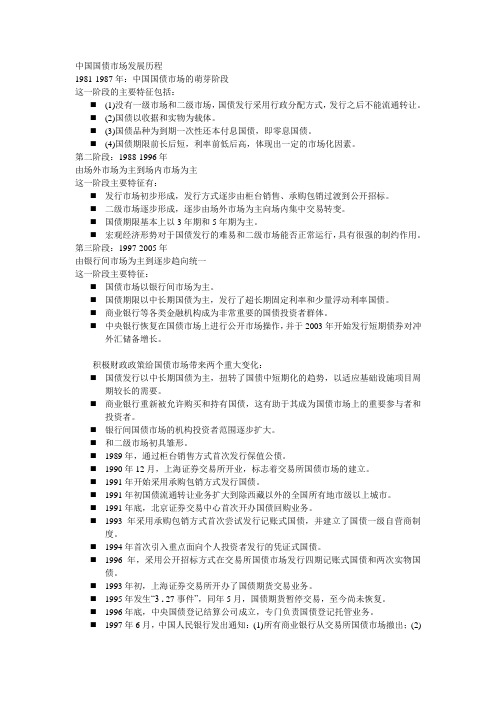
中国国债市场发展历程1981-1987年:中国国债市场的萌芽阶段这一阶段的主要特征包括:⏹(1)没有一级市场和二级市场,国债发行采用行政分配方式,发行之后不能流通转让。
⏹(2)国债以收据和实物为载体。
⏹(3)国债品种为到期一次性还本付息国债,即零息国债。
⏹(4)国债期限前长后短,利率前低后高,体现出一定的市场化因素。
第二阶段:1988-1996年由场外市场为主到场内市场为主这一阶段主要特征有:⏹发行市场初步形成,发行方式逐步由柜台销售、承购包销过渡到公开招标。
⏹二级市场逐步形成,逐步由场外市场为主向场内集中交易转变。
⏹国债期限基本上以3年期和5年期为主。
⏹宏观经济形势对于国债发行的难易和二级市场能否正常运行,具有很强的制约作用。
第三阶段:1997-2005年由银行间市场为主到逐步趋向统一这一阶段主要特征:⏹国债市场以银行间市场为主。
⏹国债期限以中长期国债为主,发行了超长期固定利率和少量浮动利率国债。
⏹商业银行等各类金融机构成为非常重要的国债投资者群体。
⏹中央银行恢复在国债市场上进行公开市场操作,并于2003年开始发行短期债券对冲外汇储备增长。
积极财政政策给国债市场带来两个重大变化:⏹国债发行以中长期国债为主,扭转了国债中短期化的趋势,以适应基础设施项目周期较长的需要。
⏹商业银行重新被允许购买和持有国债,这有助于其成为国债市场上的重要参与者和投资者。
⏹银行间国债市场的机构投资者范围逐步扩大。
⏹和二级市场初具雏形。
⏹1989年,通过柜台销售方式首次发行保值公债。
⏹1990年12月,上海证券交易所开业,标志着交易所国债市场的建立。
⏹1991年开始采用承购包销方式发行国债。
⏹1991年初国债流通转让业务扩大到除西藏以外的全国所有地市级以上城市。
⏹1991年底,北京证券交易中心首次开办国债回购业务。
⏹1993年采用承购包销方式首次尝试发行记账式国债,并建立了国债一级自营商制度。
⏹1994年首次引入重点面向个人投资者发行的凭证式国债。
中国债券市场发展历程

中国债券市场发展历程中国债券市场的发展历程可以追溯到20世纪80年代初。
在那个时候,中国的资本市场正处于起步阶段,债券市场的发展也未能得到充分重视。
1981年,中国第一次发行了国家外债券,标志着中国债券市场的起步。
在之后的几年里,中国政府开始鼓励企事业单位发行债券来筹集资金。
然而,债券市场的发展依然较为缓慢,面临诸多问题,如票面利率高、期限短、流动性差等。
1994年,中国债券市场迎来了一个里程碑式的发展。
当年,中国国债中央交易所正式成立,这标志着中国债券市场进入了现代化发展轨道。
随着中央交易所的成立,中国债券市场的交易结构和定价方式开始优化,并且债券市场的监管制度也逐渐完善。
自此以后的几年里,中国政府开始大力推动债券市场的发展。
1996年,中国开始试点发行企业债券,进一步丰富了债券市场的品种,以满足不同投资者的需求。
在随后的几年里,中国债券市场逐渐成熟发展。
2005年,中国债券市场实现了跨越式的发展,债券市场交易规模首次突破了1万亿元人民币,成为了中国资本市场的重要组成部分。
2007年,中国证券监督管理委员会正式发布《境内非金融企业债券发行和交易管理办法》,进一步完善了债券市场的发行和交易机制。
2012年,中国发展债券市场再次迈出重要一步,推出了国债期货,这是中国债券市场发展的一个重要里程碑。
借助国债期货的推出,投资者可以进行杠杆交易,更好地对冲债券价格的变动,提高市场流动性和交易活跃度。
2016年,中国债市进一步开放,取得了一系列的突破性进展。
中国正式获得入选全球债券指数(GBI-EM指数)成分国,这使中国债券市场的国际影响力大大提升,吸引了更多国际投资者进入中国债券市场。
到2020年,中国债券市场已成为全球第二大债券市场,规模超过100万亿元人民币。
同时,中国债券市场继续进行改革开放,创新发展。
中国政府推出了债券通,允许境外投资者通过对接境内交易机构进行债券投资,进一步促进了国际资本流入。
总之,中国债券市场经历了从起步到发展的历程。
论我国债券市场发展

论我国债券市场发展我国债券市场的发展历程我国债券市场是我国金融市场的重要组成部分,其发展历程可以追溯到上世纪80年代初。
当时,我国开放了债券市场,允许国外机构和个人投资者参与投资,并发行了第一批国内债券。
随着国家金融体制改革的不断推进,债券市场也在逐步完善和发展。
我国债券市场的发展可以分为初创期、成长期和成熟期三个阶段。
初创期:上世纪80年代至90年代初在这一阶段,我国债券市场还处于发展的初级阶段,市场规模较小,发行量和品种有限。
当时的债券市场主要以政府债券为主,包括国债、地方政府债券和金融债券等。
这些债券的发行主要是为了满足政府资金需求和扩大国内债务融资渠道,而非形成一个完善的市场机制。
成长期:90年代至2010年在这一阶段,我国债券市场开始逐步完善和发展。
随着国家金融体制改革的不断推进,我国的债券市场逐步实现了多元化发展。
首先是在品种上的多元化,债券市场的品种开始逐步增加,包括政府债券、企业债券、金融债券、公司债券等多种类型。
其次是在市场机制上的多元化,债券市场逐步建立了相应的市场规则和交易制度,比如债券市场的交易方式有银行间市场和交易所市场等。
在这一阶段,我国债券市场进入了成熟发展阶段,市场规模不断扩大,品种和机制不断完善。
不仅政府债券市场不断发展,企业债券、金融债券市场也取得了长足进展。
随着新三板市场的成立和债券通机制的推出,我国债券市场也逐渐向全球开放,吸引了更多国际投资者的参与。
债券市场的发展对于我国资本市场和金融体系的健康发展具有重要意义。
1. 多元化的债券品种目前我国债券市场的债券品种日益丰富,包括政府债券、央行票据、金融债券、公司债券、企业债券、地方政府债券等多种类型。
这些债券不仅可以满足不同投资者的风险偏好和投资需求,同时也为金融机构和企业提供了多元化融资渠道。
2. 市场机制逐步完善随着债券市场的发展,市场机制也在逐步完善。
目前,我国债券市场已经建立了银行间市场和交易所市场两种交易方式,同时也逐步形成了相应的市场规则和交易制度。
中国国债市场的发展历程

中国国债市场的发展历程第一阶段(1950年代-1970年代):第二阶段(1980年代-1990年代):中国在开放政策的推动下,经济发展进入快速增长阶段。
为了满足国民经济发展的需要,1981年开始,政府将国债市场定位为国家宏观调控的重要工具。
此时开始引进外国投资者参与国内债券市场,推动国债市场的国际化。
同时,随着金融体制的推进,银行间债券市场逐渐形成,为国债的交易提供了基础设施。
第三阶段(2000年代-至今):中国国债市场在2000年代迎来了快速发展的阶段。
2002年成立的中国证券登记结算有限责任公司(以下简称“中登公司”)的成立,标志着中国国债市场的日益完善和规范。
此后,政府加大了国债市场的开放力度,逐步推动国际机构和外国投资者参与。
2005年,中国发行了第一只境外人民币主权债券。
2024年底,中国国债入选摩根斯坦利资本国际系列指数,进一步提高了国债市场的国际分量。
近年来,中国国债市场的规模不断扩大,成为全球最重要的国债市场之一、政府继续推动国际化进程,例如推出了“债券通”等政策,吸引了更多的国际投资者参与。
随着中国金融市场的开放和不断深化,中国国债市场未来的发展潜力巨大。
然而,中国国债市场也面临着一些挑战。
市场的流动性仍然相对较弱,机构投资者和个人投资者的参与程度不够高。
此外,市场的信用评级制度和市场监管体系也需要进一步完善。
总的来说,中国国债市场经历了从发轫阶段到逐步发展壮大的过程。
随着中国经济的快速发展和金融市场的全球化趋势,中国国债市场有望在未来发挥更加重要的作用,并对全球金融格局产生积极的影响。
干货中国债券市场发展回顾
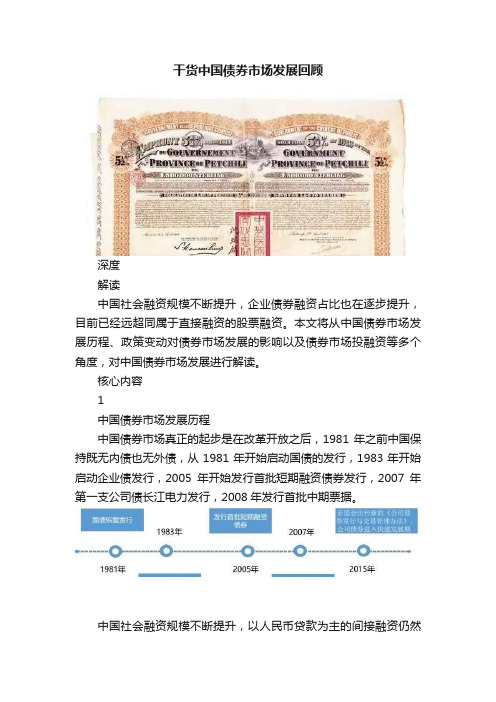
干货中国债券市场发展回顾深度解读中国社会融资规模不断提升,企业债券融资占比也在逐步提升,目前已经远超同属于直接融资的股票融资。
本文将从中国债券市场发展历程、政策变动对债券市场发展的影响以及债券市场投融资等多个角度,对中国债券市场发展进行解读。
核心内容1中国债券市场发展历程中国债券市场真正的起步是在改革开放之后,1981年之前中国保持既无内债也无外债,从1981年开始启动国债的发行,1983年开始启动企业债发行,2005年开始发行首批短期融资债券发行,2007年第一支公司债长江电力发行,2008年发行首批中期票据。
中国社会融资规模不断提升,以人民币贷款为主的间接融资仍然占据主导地位,企业债券融资占比也在逐步提升,目前已经远超同属于直接融资的股票融资。
经过过去十几年发展,中国企业债券融资占比逐步提升,从2003年1.5%提升到2016年16.85%,企业债券融资规模从2003年499亿提升至2016年29993亿元。
此外,直接融资方式中,企业债券融资占比(16.85%)已经远超非金融企业境内股票融资比例(6.97%)。
2中国债券市场结构债券根据发行主体的不同分为:国债和企业债(包括金融企业和非金融企业),一般的信用债是指企业债。
相对于国债和金融债,企业债是有一定的违约风险,所以称为信用债。
从中国整体债券市场来看,占比最大的是国债以及地方政府债,占比在35%左右,其次是金融机构发行的金融债,占比35%左右,剩下的大部分是企业债。
也就是说政府、金融债占到70%+,剩下20%+是非金融企业债。
3信用债市场概况中国信用债根据监管机构可以分为以下三类:发改委(企业债)、证监会(公司债)、银行间交易商协会(票据、短期融资券等),另外还有金融企业发债(主要是商业银行,由银监会和人民银行共同监管),包括金融债、次级债包括信贷资产证券化等。
中国企业发债最早从发改委的企业债开始,中国从计划经济过渡到市场经济,过去很多投资需要发改委审批,发改委审批项目同时提供资金配套,企业完成项目审批到募集资金过程就是融资过程。
我国债券市场的国际化进程及路径探讨
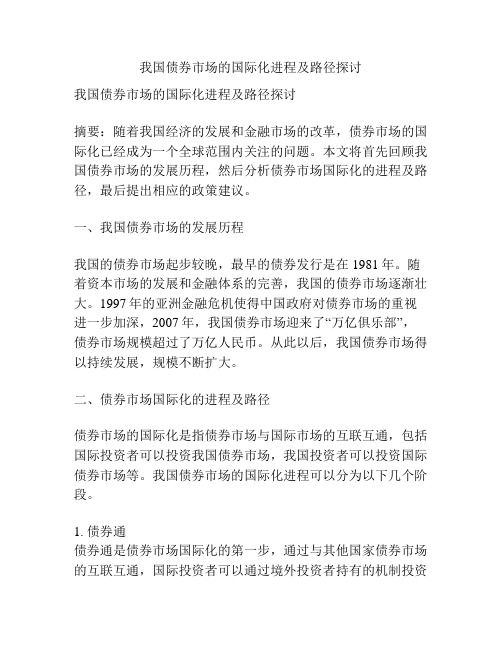
我国债券市场的国际化进程及路径探讨我国债券市场的国际化进程及路径探讨摘要:随着我国经济的发展和金融市场的改革,债券市场的国际化已经成为一个全球范围内关注的问题。
本文将首先回顾我国债券市场的发展历程,然后分析债券市场国际化的进程及路径,最后提出相应的政策建议。
一、我国债券市场的发展历程我国的债券市场起步较晚,最早的债券发行是在1981年。
随着资本市场的发展和金融体系的完善,我国的债券市场逐渐壮大。
1997年的亚洲金融危机使得中国政府对债券市场的重视进一步加深,2007年,我国债券市场迎来了“万亿俱乐部”,债券市场规模超过了万亿人民币。
从此以后,我国债券市场得以持续发展,规模不断扩大。
二、债券市场国际化的进程及路径债券市场的国际化是指债券市场与国际市场的互联互通,包括国际投资者可以投资我国债券市场,我国投资者可以投资国际债券市场等。
我国债券市场的国际化进程可以分为以下几个阶段。
1. 债券通债券通是债券市场国际化的第一步,通过与其他国家债券市场的互联互通,国际投资者可以通过境外投资者持有的机制投资我国债券市场。
目前,我国与香港实行了债券通机制,成为债券市场国际化的重要窗口。
2. 市场互联互通市场互联互通是指我国债券市场与其他国家债券市场的互联互通,包括债券市场的交易互联互通、结算互联互通等。
近年来,我国与欧盟、新加坡、伦敦等地的债券市场相继实行了市场互联互通,为投资者提供了更多的投资机会。
3. 币种国际化币种国际化是债券市场国际化的重要手段之一。
目前,我国债券市场主要以人民币计价和结算,但是人民币的国际化进展还相对较慢。
未来,我国应努力提升人民币的国际地位,为债券市场国际化做好准备。
4. 机构国际化机构国际化是债券市场国际化的关键。
目前,我国的金融机构在国际市场上的影响力相对较小,需要进一步提升国际竞争力。
我国应加强金融机构的国际化培养,培养具有国际竞争力的金融机构。
5. 规则国际化规则国际化是债券市场国际化的基础。
我国国债市场发展回顾与促进市场高质量发展的建议研究

我国国债市场发展回顾与促进市场高质量发展的建议研究我国国债市场在改革开放40年的时间里经历了从无到有,从小到大,从封闭到开放的发展历程。
近年来,随着金融市场改革的深入和投资者对债券市场的逐渐认可,国债市场在我国金融体系中的地位逐渐提升。
本文对我国国债市场的发展历程进行回顾,并提出促进国债市场高质量发展的建议。
一、我国国债市场发展历程回顾我国国债市场的建立起始于1981年,当时面临着通货膨胀、信贷紧缩等问题,为了解决这些问题,国家发行了第一笔国债。
此后,国家债券作为最具代表性的债券品种逐渐被投资者所熟知和接受。
1997年,我国发行了第一批政府债券,标志着我国政府债券市场的正式成立。
2005年,中央政府债券登陆香港,开启了我国政府债券在国际市场的交易。
随着债券市场的逐渐壮大,2016年我国国债入选彭博巴克莱全球指数,成为全球债券市场的重要组成部分之一。
二、我国国债市场存在的问题1. 市场深度不足:我国国债市场的规模虽然已经逐渐扩大,但市场深度仍然不足,流动性有限。
2. 市场的去杠杆化对债券市场出现一定程度的压力。
3. 个人投资者参与意愿不足,使市场的国债持有多集中在少数机构手中。
4. 市场价格波动明显,市场风险较高。
三、促进国债市场高质量发展的建议1. 拓宽国债市场来源渠道并提高市场深度:在流动性方面,应尽快增加债券的供给量,提高市场可操作性。
2. 改善市场定价机制,提高市场透明度:通过完善债券定价机制、加强信息披露、提高市场透明度等,以吸引更多个人投资者参与市场。
3. 支持机构投资者发展:红利再投资制度、债券交易计划等。
通过完善机构投资者参与体系,提高国债市场的市场深度和流动性。
4. 提升国债市场的好评度和认知度:政策性债券等,以提高市场知名度和好评度。
通过以上建议,可以促进国债市场的高质量发展,使其在稳定社会经济、发挥资金运作的重要作用的同时,也提高了市场透明度、流动性和交易效率,更好地服务于国家和时代需求。
- 1、下载文档前请自行甄别文档内容的完整性,平台不提供额外的编辑、内容补充、找答案等附加服务。
- 2、"仅部分预览"的文档,不可在线预览部分如存在完整性等问题,可反馈申请退款(可完整预览的文档不适用该条件!)。
- 3、如文档侵犯您的权益,请联系客服反馈,我们会尽快为您处理(人工客服工作时间:9:00-18:30)。
1998年开始实施积极财政政策 Experience from 1997 to 2005(p.3)
1998年起取消实物国债。 Physical bonds were canceled in 1998. 积极财政政策给国债市场带 The proactive fiscal policy 来两个重大变化: brings two great changes to 国债发行以中长期国债为主, government bonds market: 扭转了国债中短期化的趋势, Government bonds issue take 以适应基础设施项目周期较 medium and long-term national 长的需要。 debt as the main type, in order 商业银行重新被允许购买和 to meet longer requirement in project cycle of the 持有国债,这有助于其成为 infrastructure. 国债市场上的重要参与者和 Commercial banks were 投资者。 allowed to buy and hold the
中国国债市场发展历程与经验介绍
A Brief Introduction to China’s Domestic Government Bond Market
一、中国国债市场发展历程 (Development Experience in Government Bond Market ) 第一阶段(the first period):1981-1987年 第二阶段(the second period) :1988-1996年 第三阶段(the third period) :1997-2005年 二、中国国债市场发展经验与展望 (Prospect of China’s Government Bond Market)
government bonds again.
1997-2002年:以银行间市场为主的国债市场 Experience from 1997 to 2005(p.4)
During 1997-2002: 银行间国债市场的机构投资者 The amount of institutional investors at Inter范围逐步扩大。 bank Market increased progressively . 2000年起建立国债承销团制度, Set up the system of underwriting syndicate of treasury bonds from 2000, announce the 按季公布国债发行计划。 issuing schedule quarterly. 2002年,四家国有商业银行在 In 2002, four state-own commercial 部分地区开办记账式国债柜台 began OTC trading of treasury bondsbanks in some 买卖业务。 areas. 1999年对国债发行架构作出调 from the year 1999,(1)The issued amount of 整:(1)每年凭证式国债发行额 the annual document-based saving bonds 保持稳定,逐步提高记帐式国 remains stable, improve the proportion of 债发行额所占比重;(2)定期滚 issued amount of book entry bondsively ; (2)make a regular and rolling 长期国债为主;(3)发行跨市场 schedule of fixed rate bonds; (3)Issue book 记账式国债,促进国债市场统 entry bonds throughout two markets, in order (4)Choose the 一;(4)选择时机发行超长期国 to make market unified ;ultra long-term bonds, opportunity to issue the 债,进一步完善国债期限结构。 perfect the term structure of the treasury bonds.
第二阶段:1988-1996年 (三) Experience from 1988 to 1996(p.3)
(1) In 1993, book entry bonds 1993年采用承购包销方式首次 were underwritten for the first time. 尝试发行记账式国债,并建立 Primary Dealer system was established. 了国债一级自营商制度。 In 1994, started issuing 1994年首次引入重点面向个人 document-based saving bonds , 投资者发行的凭证式国债。 which is mainly toward individual 1996年,采用公开招标方式在 investor. 交易所国债市场发行四期记账 In 1996, four book entry bonds and two physical bonds were 式国债和两次实物国债。 issued, by the competitive bidding 1993年初,上海证券交易所开 way in exchange market. At the beginning of 1993, 办了国债期货交易业务。 1995年发生“3 . 27事件”, Shanghai Stock Exchange began the futures business of Treasure 同年5月,国债期货暂停交易, Bonds. 至今尚未恢复。 In 1995, “3. 27 incident ” broke out. Bonds futures paused.
中国国债市场发展历程 与经验介绍
A Brief Introduction to China’s Domestic Government Bond Market
财政部国库司副司长: 周成跃
Zhou Chengyue Deputy Director-General ,Treasury Department, MOF,PRC 2005年4月27日 April 27, 2005
第二阶段:1988-1996年 (二) Experience from 1988 to 1996(p.2)
1988年:尝试通过柜台销售方 式发行国债,开始国债流通转 让试点,国债发行市场和二级 市场初具雏形。 1989年,通过柜台销售方式首 次发行保值公债。 1990年12月,上海证券交易 所开业,标志着交易所国债市 场的建立。 1991年开始采用承购包销方式 发行国债。 1991年初国债流通转让业务扩 大到除西藏以外的全国所有地 市级以上城市。 1991年底,北京证券交易中心 首次开办国债回购业务。 In 1988:issued bonds through bank’s counter. treasury bond secondary market was established. In 1989, issued inflation-proof bonds for the first time. In December of 1990, Shanghai Stock Exchange was open, marking the setting-up of the bond market at exchange. Began to issue bonds by Syndicate underwriting in 1991. In 1991,bond trading could be done in every province besides Tibet. At the end of 1991, the securities trade center of Beijing began to deal with Repo trading.
第二阶段:1988-1996年 由场外市场为主到场内市场为主(一) Experience from 1988 to 1996
During this period : 这一阶段主要特征有: Primary market appeared, 发行市场初步形成,发行方 issuing method was upgraded 式逐步由柜台销售、承购包 from underwriting to competitive 销过渡到公开招标。 bidding. 二级市场逐步形成,逐步由 Secondary market was 场外市场为主向场内集中交 established, most trade was at 易转变。 Stock Exchange. 国债期限基本上以3年期和5 Term structure: mainly 3-year and 5-year bonds. 年期为主。 宏观经济形势对于国债发行 Correlation between Bond 的难易和二级市场能否正常 market and Macro economic situation 运行,具有很强的制约作用。 morewas becoming more and obvious.
第三阶段:1997-2005年 由银行间市场为主到逐步趋向统一 Experience from 1997 to 2005
During this period: 这一阶段主要特征: The government bonds market 国债市场以银行间市场为主。 takes Inter-bank market as the core. 国债期限以中长期国债为主, 发行了超长期固定利率和少 Term structure : main part is medium and long-term bonds, 量浮动利率国债。 also issued ultra long-term fixed 商业银行等各类金融机构成 interest rate bonds ,and a small 为非常重要的国债投资者群 amount of floating interest rate bonds. 体。 Financial institutions become 中央银行恢复在国债市场上 important investors of government bonds. 进行公开市场操作,并于 Central Bank resumed Open 2003年开始发行短期债券对 Market Operation in government 冲外汇储备增长。 bonds market, and began issuing short-term Bills in 2003 to offset increasing foreign exchange reserve.
